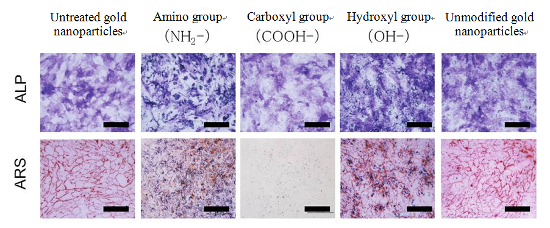Development of Gold Nanoparticles That Control Osteogenic Differentiation of Stem Cells
Surface Modification by Carboxyl Groups Suppressing Osteogenic Differentiation. Nanomaterials Paving the Way for Regenerative Medicine
2015.04.07
(2015.05.19 Update)
National Institute for Materials Science (NIMS)
Tissue Regeneration Materials Unit at MANA, NIMS successfully developed gold nanoparticles that have functional surfaces and act on osteogenic differentiation of stem cells.
Abstract
- Tissue Regeneration Materials Unit (Guoping Chen, Unit Director) at the International Center for Materials Nanoarchitectonics (MANA) (Masakazu Aono, Director General, MANA), NIMS (Sukekatsu Ushioda, President) successfully developed gold nanoparticles that have functional surfaces and act on osteogenic differentiation of stem cells. This research result had been published online version of journal Biomaterials on 6 April 2015 (Jasmine Jia’En Li, Naoki Kawazoe and Guoping Chen, Title: “Gold nanoparticles with different charge and moiety induce differential cell response on mesenchymal stem cell osteogenesis”, 2015 Jun 6; 54: 226-36, doi:10.1016/j.biomaterials.2015.03.001)
- In regenerative medicine, the technology to control stem cell functions such as differentiation and proliferation is indispensable. It has been reported that nanosized gold particles promote the differentiation of human mesenchymal stem cells into osteoblasts. Also, other studies suggested that various functional groups such as amino, carboxyl and hydroxyl groups promote or inhibit stem cell differentiation. Based on these reports, we assumed that gold nanoparticles with surface modified with functional groups is a promising candidate to control stem cell functions. However, specific effects of such particles on the differentiation of human mesenchymal stem cells was unknown.
- We synthesized gold nanoparticles with surface modified with one of the following functional groups: a positively-charged amino group (-NH2), a negatively-charged carboxyl group (-COOH) or a neutral hydroxyl group (-OH), and identified how they affect the osteogenic differentiation of mesenchymal stem cells that were derived from human bone marrow. Among these three types of nanoparticles, those with the carboxyl groups were uptaken by cells and exhibited a strong bone differentiation-inhibitory effect compared to the other types of nanoparticles. Furthermore, we investigated the effect of gold nanoparticles with carboxyl groups on the gene expression profile of mesenchymal stem cell from human bone marrow. The results indicated that the nanoparticles inhibited several gene expressions related to osteogenic differentiation. Therefore, the influence of the gold nanoparticles on promoting or inhibiting osteogenic differentiation varied depending on the types of functional groups.
- In view of regenerative medicine, it is essential to develop technology enabling controlling stem cell functions as well as safe and high-quality stem cells. In the present study, we attempted to control stem cell functions through material manipulation, and our findings will contribute to the creation of novel nanomaterials that facilitate the advancement of stem cell manipulation. We intend to build upon these results in our future endeavors in developing regenerative medicine.

Figure: Human mesenchymal stem cells (hMSCs) resulted from the following steps: each type of gold nanoparticles was added to hMSCs, and the treated cells were cultured for 3 weeks. The cells received either alkaline phosphatase (ALP) staining or alizarin red staining (ARS) of calcium phosphate deposits, both of which are osteogenic differentiation indicators. Control experiments with unmodified gold nanoparticles and untreated hMSCs were also carried out for comparison. In the upper images, ALP positive cells were stained purple while agglomerates of gold nanoparticles were detected as blue dots. In the lower images, spider-web-like red stains represent calcium phosphate deposits while bluish purple dots indicate agglomerates of gold nanoparticles. All scale bars are 500 μm.
